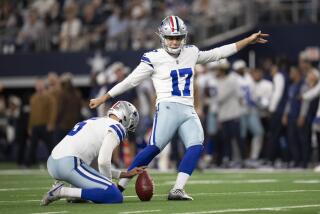Physicists solve the mystery behind a 1997 soccer miracle
- Share via
Forget about bending it like Beckham -- can you curve it like Carlos?
All right, so this is a little beyond the normal health boundaries, but for more of our active, sporty, specifically soccer-loving readers, a new study in the New Journal of Physics solves the longstanding mystery of whether a dramatic goal in an international match more than a decade ago was due to athletic skill or dumb luck.
The French researchers looked at a famous free kick goal made by Brazilian player Roberto Carlos against the French team in the 1997 Tournoi de France. When observed straight on, the ball makes a dramatic zigzag, flying far to the right of the goalpost before shooting back in.
Some had attributed it to accuracy; others called it a fluke. But the physicists say that from that distance, at the speed the ball was traveling, the goal was practically inevitable.
Study coauthor Christophe Clanet, a physicist at the Ecole Polytechnique in Palaiseu, France, said at first, the study didn’t pique his interest: After all, it was well known that a spinning ball will have a curved trajectory, a phenomenon known as the Magnus effect.
To test whether that was the explanation in the soccer match, the physicists fired balls into water with a slingshot (making sure the ball’s buoyancy wouldn’t affect the results) and recorded its path.
What they found surprised Clanet. The spinning ball didn’t just curve; it spiraled. In a world free of gravity, the physicist said, the ball would appear to shoot straight for a while and then suddenly coil in on itself, slowing down and stopping once it reached the center of that trajectory.
Clanet said the main lesson here was for goalkeepers to watch out for strong kickers aiming from that sweet spot 35 meters away.
Why hadn’t this curl been seen before? The key was distance: Carlos took his kick from 35 meters out -- a long way compared with the 18-25 meters that players tend to kick from. That means the ball usually made -- or missed -- the goal before having a chance to make its sharp turn.
Carlos is known to kick hard -- in the range of 130 km per hour -- and the ball’s speed practically canceled out gravity, allowing the spiral to come into play.
If Carlos had been any closer, the ball would have missed the goal before it had a chance to curve around. And if he had kicked the ball from any farther back, the ball might have curved too much and shot past the goalposts, or hit the ground and lost the spiral.
So did Carlos know what he was doing when he made that kick, or was it purely accidental? Clanet pointed to the pinpoint accuracy with which these professional players could kick, and their years of experience on the field. “I’m pretty sure he knew the trajectory at this distance was special,” he said.
-- Amina Khan / Los Angeles Times
Back to the Booster Shots blog.
More to Read
Go beyond the scoreboard
Get the latest on L.A.'s teams in the daily Sports Report newsletter.
You may occasionally receive promotional content from the Los Angeles Times.






